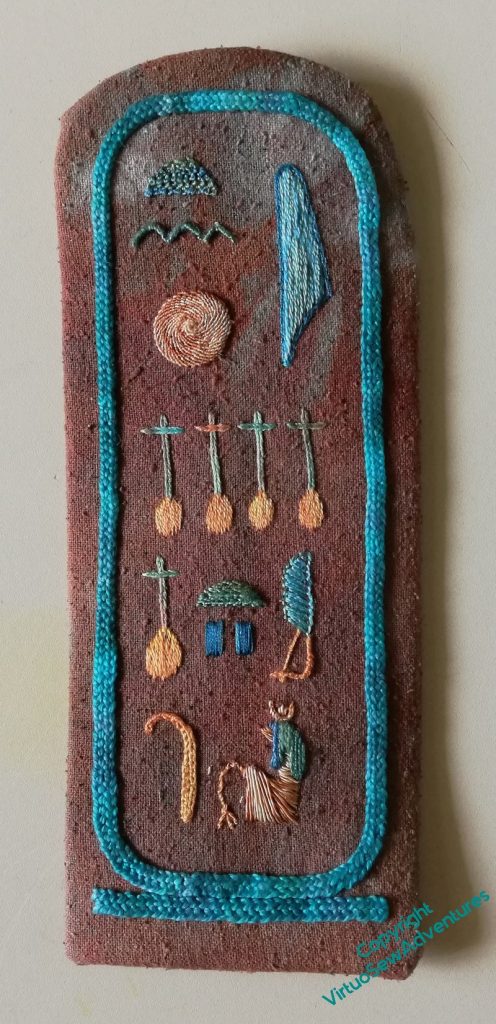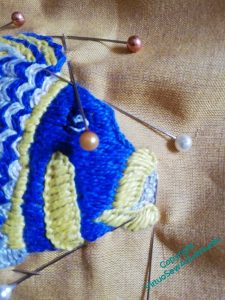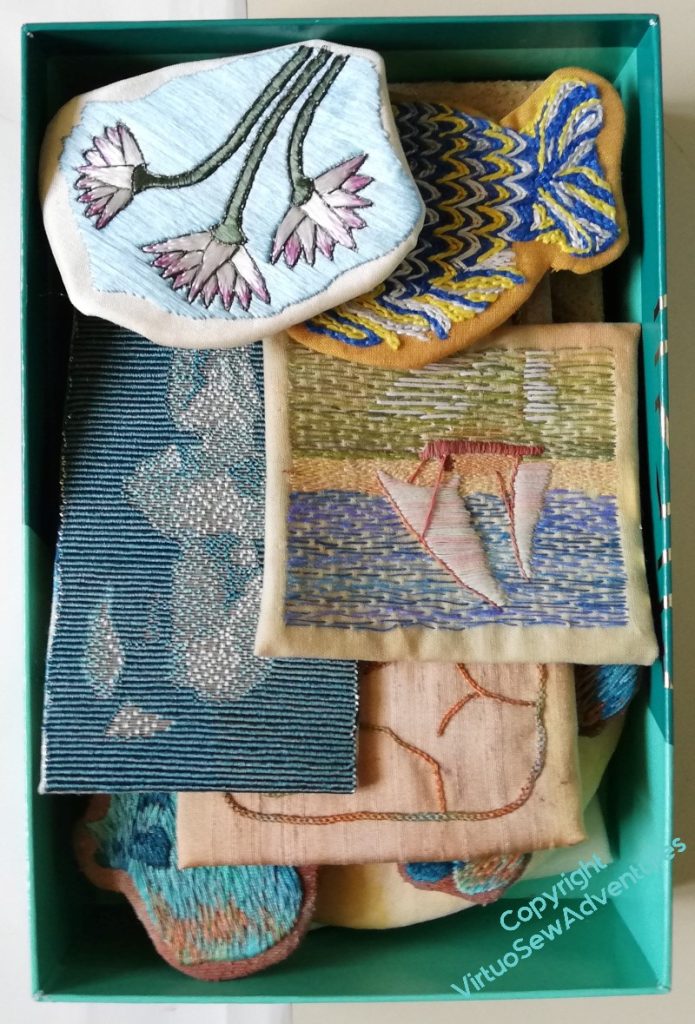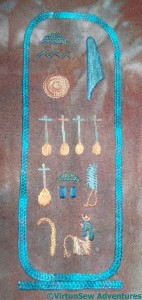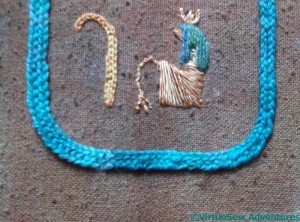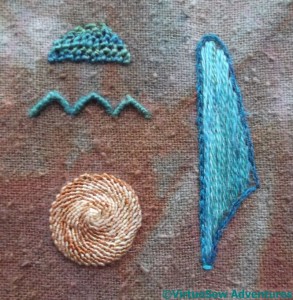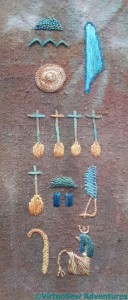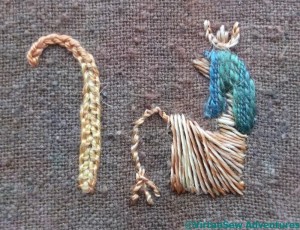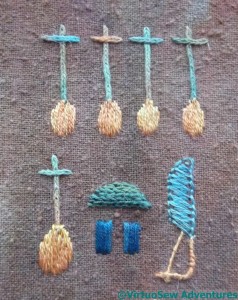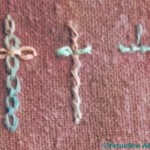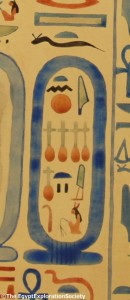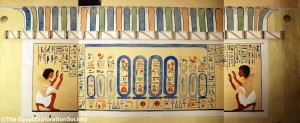Tag: Cartouche of Nefertiti
More spots prepared
Originally the Cartouche was going to be rectangular, but as I started to cut the pelmet vilene I’m mounting the spots on, it began speaking to me very firmly.
Long term readers know that this sometimes happens to me, and I have learnt over the years that the sensible thing to do is listen. My projects almost always know better than I what they need to thrive.
In this case, I was informed that I should make the cartouche mounting echo the curves at the top while keeping the square edges at the bottom. It wasn’t easy to do – that silk noil fabric has a way of misbehaving that would make Robin Goodfellow whistle admiringly! – but now it is done, I’m inclined to agree.
The next spot I tackled was if anything an even greater challenge – a fiddly shape (really fiddly!), in quite a light fabric, which didn’t always respond as I expected.
You can see here just how be-pinned and be-poked the poor Tilapia became! There was much clipping and snipping, muttering and tugging, before I produced something that looked at all pleasing. Maybe that’s just to remind me of the reason I did him – hearing a modern glass artist saying that he’d tried to recreate the ancient glass vessel and found it really difficult – to such an extent that even with much practice, he couldn’t expect every fish to go swimmingly (as it were…!).
So, after much cutting and stitching, tugging and thinking, I’ve mounted all the Spots around shaped pieces of pelmet vilene, ready to be attached (somehow!) to the main colour block panels of the two main Amarna pieces.
Gratifyingly, they all have much more vivid personalities than the photocopies I’ve been using to plan their placement, so I think that will genuinely work. Thank goodness!
In the meantime, I’ve got them piled up in a box, all shouting at once that they consider themselves Absolutely Splendid, and will I please Get On With It…!
Working on Nefertiti’s Cartouche – 3
I did a lot of staring balefully.
I picked out a whole selection of threads, looked at them, and dismissed them. Partly, it must be said, because I had decided, after all, to use Plaited Braid Stitch, and that uses a lot of thread. I wasn’t sure that I even had enough of some of my choices!
In the end, I decided to use an overdyed pearl cotton in a sort of faience colour. Years ago, my mother managed plaited braid stitch using stranded cotton, but I tend to feel that that is making life unnecessarily difficult, so stranded threads or floppy threads were removed from consideration as soon as I had settled on the stitch…
I must say, I hadn’t expected to find the stitch getting narrower as I became more practised. I had to deliberately broaden the stitch as I got nearer to the start so I had some chance of joining the ends neatly.
And I really don’t think I did too badly – in fact, if it weren’t for the colour change, I think the join would be rather hard to spot!
And by the way – the dreaded Plaited Braid Stitch is no longer dreaded!
Working on Nefertiti’s Cartouche – 2
After I’d finished the spiral trellis stitch circle, I had some doubts about it. Maybe it wasn’t strong enough, maybe the texture clouded the impression of the shape, maybe it even killed the colour. I’ve decided – with continuing reservations! – to keep it for now. I like the effect, and the knotted texture contrasts nicely with the long and short stitch beside it. If it can’t live with its companions when I’ve finished the piece, I will be in a better position to work out how to replace it.
The zigzag is about as simple as it could be – straight stitches, tightly whipped – and the half-circle, like the one in the lower section, is detached buttonhole stitch.
So far, so good.
All the individual hieroglyphs have been worked, and I think the colour balance has turned out pretty well.
However, cartouches have borders, and the border is giving me a raging headache!
I had thought of working the border in Plaited Braid Stitch, in a copper or gold, or maybe couching down a knitted ribbon. Maybe a border in some other stitch, in blue-green?
So far, every thread I’ve tried has either disappeared into the background, or made itself altogether too obtrusive. I can see myself staring balefully at it for weeks, so in the meantime I am going to tack guidelines for the eventual border (in silk, what else?) and hope that inspiration dawns…
Working on Nefertiti’s Cartouche – 1
I need to learn to believe in myself more. As I was stitching this little seated figure, I was really very doubtful about it. I was twisting the sandy silk filament for every stitch, and it was being difficult, and looking rather odd and clunky.
Then I added the wig, in a variegated – and slightly slubby – silk perle, and suddenly I’m completely captivated!
The walking-stick like thing is a row of chain stitch with detached buttonhole stitch added to broaden the shaft. I think that works rather nicely, too.
There was a slight false start with the row of spoon-like things. After I did the bottom row of this pair, ending with a crossed spoon in heavy chain stitch and long and short stitch, I wondered whether perhaps I should vary the stitches in the row above. An experiment in that direction soon proved me wrong, though!
The two little blocks started out as closed herringbone stitch, but that looked scrappy and a bit twisted. I left the closed herringbone stitch in place, and covered it with satin stitch, breathing a sigh of relief when it worked.
The fabric is the same as I used for the Faience Hippopotamus, and it’s frightfully difficult to photograph. No matter what I do, the colour careers around the spectrum, and the grey, overcast days aren’t helping, either.
Nor is it especially easy to stitch on. It doesn’t look like a loose weave, but it behaves like one, even though I’ve supported it with a piece of calico. Stitches that I like using are proving unsuccessful and behaving oddly. All in all, although I’m enjoying it, it feels most peculiar!
The Cartouche of Nefertiti
Akhenaten and his Great Royal Wife Nefertiti are prominent characters in Mary Chubb’s imaginative response to the city they built, so I feel they need to appear more than once in the embroidery as well. The trick is to balance the story of the archaeology and the archaeologists with the story of the ancient inhabitants..
The gauze overlays I plan will give the sense of the Pharoah and his Great Royal Wife brooding over their city, but among other things I want to include their cartouches.
A few weeks ago, I attended an evening lecture about woven patterns discovered by Howard Carter in Tutankhamun’s tomb (more on that another time!) at the Egypt Exploration Society, and spoke briefly with the Director, Chris Naunton, who has been very helpful to my research in the past. I mentioned that I would like to do at least one set of cartouches in colour. There was a thoughtful pause, then he said “I think I have the very thing – send me an email to make sure I don’t forget, but it is just a matter of finding the file!”
I hadn’t even arrived home the next day when an email showed up in my inbox. The image showed a composite of watercolours by Hilda Pendlebury, depicting Hatiay’s Lintel. This was a carved and painted door-lintel discovered in the very season Mary was writing about, and what’s more, mentioned at some length in the book. It was both archaeologically and historically interesting (two of the cartouches were scratched out in antiquity), as well as providing a challenge to transport, being large, heavy, and because of the embellishment rather fragile.
My current thought is that I will work a version of the cartouche of Nefertiti, either in cottons or silks, either directly on the pale faience coloured linen or maybe on the fabric I used for the Faience Hippopotamus, which would help to balance him slightly. I’ve been reassured that I won’t give any Egyptologists apoplexy if I tweak the colours slightly….!

